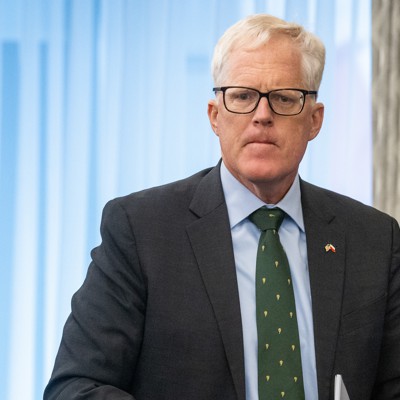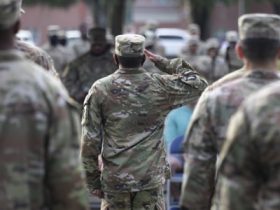Few people, if any, have a better window into Donald Trump’s plans for the Pentagon than Christopher Miller, the final acting defense secretary of Trump’s first term and architect of the defense chapter of the Project 2025 document.
Two people with knowledge of the Trump campaign’s internal deliberations told Defense One that Miller is well-placed to play a key role in the next White House’s national security apparatus. And while Trump sought to distance himself from the Heritage Foundation document after its many controversial elements rose to public attention, it was written largely by his former appointees and staff and mirrors many of his policy proposals.
Although he has acted as one, Chris Miller is no one’s idea of a defense secretary—not even Chris Miller’s. A retired Army Special Forces colonel who later ran the National Counterterrorism Center, he lacks the defining qualities of a Washington political operator. He shows no enthusiasm for delivering talking points or speeches; takes no joy in commanding large budgets; expresses no interest in waging culture-war battles in front of cameras. He shares Trump’s extemporaneous, unscripted speaking style but none of his former boss’s vindictiveness. Miller is far more likely to extend praise to those in the security space whose work he admires than complain about people. (Although he is quick to find colorful language to condemn what he sees as bad ideas and failures, particularly the 2021 Afghanistan pullout.) In a town that runs on political ambition, Miller displays annoyance both at the question of what role he might play in a future Trump administration and, it seemed, at the very possibility. There is no private version of Miller that contrasts with a public persona. He’s most at home in the attire of a man about to go fishing for the day and many, especially Miller himself, consider him too unpolished (read: free with his opinions) to make it through a Senate confirmation hearing. But given Trump’s expressed preference for acting cabinet secretaries rather than confirmed ones, that is not the barrier it once was. And Miller’s low-ego personality could serve him well in an Oval Office run by a man with ego to spare.
We caught up with Miller in June to discuss how the Defense Department might change in a second Trump term and to hear his own priorities and thoughts on the future of U.S. defense. In the interview, he said the Project 2025 defense chapter was a collaborative work, involving multiple contributors and committees. He described his role as “herding cats.” Regardless, Miller was happy to endorse and expound on several of its key provisions, many of which did originate from him.
Innovation
Unlike many of the better-known, more partisan parts of the Heritage Foundation’s voluminous Project 2025 document, the chapter on defense contains points and proposals that echo what many national security professionals have been urging for years, and many that the Biden White House has itself attempted to implement. One of these is a core focus on innovating and deploying new weapons far more quickly. His main complaint about current innovation efforts like the Replicator program and even the Defense Innovation Unit is that such efforts aren’t matched with real dollars.
Miller says he would place far greater emphasis on ideas and innovations that emerge from within the department, particularly at the operator level.
“Here’s my idea, push down to every battalion-sized unit across all of the services an innovation fund..and let’s go bottom up,” he said in the interview. “Push decentralized innovation down to the kids in the field. Provide them some seed money.”
Miller also wants to tackle the culture of risk aversion that especially permeates the middle tier of the services by prodding inspectors general to better monitor how innovation funds are spent.
“They go in each year and guarantee that the money is being spent appropriately, that it’s tied to the commander’s vision and all that. Then we just institutionalize it across the force,” he said.
Irregular warfare
Unsurprisingly, Miller, a former Army Green Beret who first arrived in Afghanistan in December 2001, does not agree with the service’s plan to cut U.S. special operations forces.
Miller wants irregular warfare to have a larger, even predominant, role in implementing U.S. policy in South and Central America and Africa—and a smaller one in the Pacific.
“Let Special Operations Command, irregular warfare command, handle Latin America and AFRICOM. Let them compete against whoever it is out there. Let the services just focus on INDOPACOM and the Russian bear.”
It’s a new version of an idea that won serious consideration in the early days of the 2001 operations in the Middle East. Ultimately, combatant commanders killed it, he said. “All the geographic combat commanders just crushed that because of their authorities and their prerogatives.”
Defense intelligence
The Project 2025 document calls for substantial reform of the defense intelligence apparatus, away from “peripheral intelligence obligations that do not advance military readiness,” including screening people for security clearances.
Miller sees a possible combined role for defense intelligence and special operations, in effect transforming the latter into a quasi-intelligence service in order to better anticipate rapidly shifting geopolitical crises. It’s a vision similar to that espoused in 2016 by then-SOCOM commander Gen. Tony Thomas.
“This is nothing new. It’s been kicked around for ages,” Miller said “There’s this almost knee-jerk reaction to it related to civil liberties, that if you have an operational element and an intelligence element working together somehow you might violate American civil liberties. I don’t see that. It requires cognizant oversight and serious attention. But we know how to do that.”
Miller would also place more emphasis on rapid collection and analysis of open-source intelligence.
“We haven’t even scratched the surface of the power of open-source intelligence, and we’re still kind of stuck in these silos,” he said.
Space and tactical nuclear weapons
The Project 2025 document calls on the United States to “develop a nuclear arsenal with the size, sophistication, and tailoring—including new capabilities at the theater level—to ensure that there is no circumstance in which America is exposed to serious nuclear coercion.”
Miller said that the issue of low-yield tactical nuclear weapons was a heated one during the Project 2025 committee deliberations and would likely continue to be. But he’s willing to consider adding them to America’s nuclear arsenal.
On space, Miller said the Pentagon can’t simply rely on an abundance of cheap, low-earth orbit satellites for resilience.
“Obviously, treaty restrictions for weaponizing space have to be considered. A lot of that is talking about not just space-based weapons, but also cyber effects, other effects,” he said.
National Guard
Miller expressed little enthusiasm for a proposal by former Trump advisor Stephen Miller to send the National Guard into American cities to help deport people over governor objections.
“I think the risks are a little hyperbolic,” he said of the notion sending National Guard units from state to another, even against the will of governors. “There are enough fire breaks in there” to prevent misuse.
But he believes that border security is a natural fit for the Guard, which has been helping there for years. Beyond that, he said individual governors should determine the duties of their state’s Guard units, while the Pentagon trains and equips Guard units to help deter potential foreign adversaries.
Alliances
The public perception of Trump as eager to abandon NATO—a perception Trump himself has at times advanced—doesn’t represent his previous administration’s actual policy or current thinking, which primarily emphasizes a need for NATO nations to spend more on collective defense, an idea that alliance officials have also supported.
Miller, too, dismissed the notion that Trump was preparing to storm out of the alliance.
“Everybody is concerned that [Trump] means a wholesale pullout of NATO or other organizations. I find that probably a stretch. The ultimate point is better burden-sharing.”
That expectation for greater individual defense spending by partner militaries would also extend to other countries, such as South Korea.
On the topic of joint development, particularly of ships, Miller sounds more like the present Defense Department than the next one. The United States alone just doesn’t have the ship-building capabilities to meet the former Trump administration goal of a 350-ship Navy, let alone the service’s current stated goal of 381.
“The prohibition against U.S. Navy ships being built in foreign shipyards—I understand the reason for that, but there are national-security waivers. So why don’t we have a serious conversation about shipbuilding capacity in Japan, South Korea? There are other places. You can probably get the Philippines. Australia as well.”
That opinion, he said, was very much a personal one.
“This is where I am, not where Heritage is. Freaking, I have no idea where the Trump campaign is.”
Read the full article here








Leave a Reply